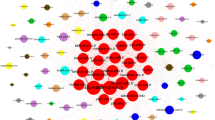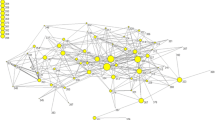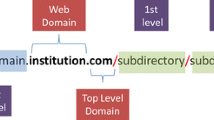Abstract
This study examined why Websites were co-linked using Canadian university Websites as the test set. Pages that co-linked to these university Websites were located using Yahool. A random sample of 859 co-linking pages (the page that initiated the co-link) was retrieved and the contents of the page, as well as the context of the link, were manually examined to record the following variables: language, country, type of Website, and the reasons for co-linking. The study found that in over 94% of cases, the two co-linked universities were related academically; many of these cases (38%) showed a relationship specifically in teaching or research. This confirms results, from previous quantitative studies, that Web co-links can be a measure of the similarity or relatedness of sites being co-linked and that Web co-link analysis can thus be used to study relationships among linked Websites.
Similar content being viewed by others
References
Allen, E. S., Burke, J. M., Welch, M. E., Rieseberg, L. H. (1999), How reliable is science information on the web? Nature, 402: 722.
Association of Universities and Colleges of Canada (2005), Canadian Universities. http://www.aucc.ca/can_uni/our_universities/index_e.html (accessed January 17, 2005)
Bar-Ilan, J. (2004), A microscopic link analysis of academic institutions within a country — the case of Israel. Scientometrics, 59(3): 391–403.
Bar-Ilan, J. (2005), What do we know about links and linking? A framework for studying links in academic environments. Information Processing & Management, 41(4): 973–986.
Berg, B. L. (1995), Qualitative Research Methods for Social Science, 2nd ed. Boston: Allyn and Bacon.
Crowston, K., Williams, M. (2000), Reproduced and emergent genres of communication on the world wide web. The Information Society, 16: 201–215.
Google (2006). Google Web APIs Reference, http://www.google.com/apis/reference.html#2_2 (accessed April 11, 2006).
Jepsen, E. T., Seiden, P., Iingwersen, P., Björneborn, L., Borlund, P. (2004), Characteristics of scientific web publications: preliminary data gathering and analysis. Journal of the American Society for Information Science and Technology, 55(14): 1239–1249.
Johnston, A. D. (Ed.) (2004), Maclean’s Guide to Canadian Universities 2004, Toronto, Canada: Rogers Publishing.
Kim, H. J. (2000), Motivations for hyperlinking in scholarly electronic articles: a qualitative study. Journal of the American Society for Information Science, 51(10): 887–899.
Smith, A. G. (2004), Web links as analogues of citations. Information Research, 9(4), paper 188, available http://informationR.net/ir/9-4/paper188.html
Thelwall, M. (2001), Extracting macroscopic information from Web links. Journal of the American Society for Information Science and Technology, 52(13): 1157–1168.
Thelwall, M. (2002), Evidence for the existence of geographic trends in university web site interlinking. Journal of Documentation, 58(5): 563–574.
Thelwall, M. (2003). What is this link doing here? Beginning a fine-grained process of identifying reasons for academic hyperlink creation. Information research, 8(3), paper 151, available http://informationr.net/ir/8-3/paper151.html
Thelwall, M. Vaughan, L., Cothey, V., Li, X., Smith, A. G. (2003), Which academic subjects have most online impact? A pilot study and a new classification process. Online Information Review, 27(5): 333–343.
Vaughan, L. (2006). Visualizing linguistic and cultural differences using Web co-link data. Journal of the American Society for Information Science and Technology, 57(9): 1178–1193.
Vaughan, L., Gao, Y., Kipp, M. (2006), Why are hyperlinks to business Websites created? A content analysis. Scientometrics, 67(2): 291–300.
Vaughan, L., Thelwall, M. (2005), A modeling approach to uncover hyperlink patterns: The case of Canadian universities. Information Processing & Management, 41(2): 347–359.
Wilkinson, D., Harries, G., Thelwall, M., Price, E. (2003), Motivations for academic Web site interlinking: Evidence for the Web as a novel source of information on informal scholarly communication. Journal of Information Science, 29(1): 59–66.
Author information
Authors and Affiliations
Corresponding author
Rights and permissions
About this article
Cite this article
Vaughan, L., Kipp, M.E.I. & Gao, Y. Why are Websites co-linked? The case of Canadian universities. Scientometrics 72, 81–92 (2007). https://doi.org/10.1007/s11192-007-1707-y
Received:
Published:
Issue Date:
DOI: https://doi.org/10.1007/s11192-007-1707-y




